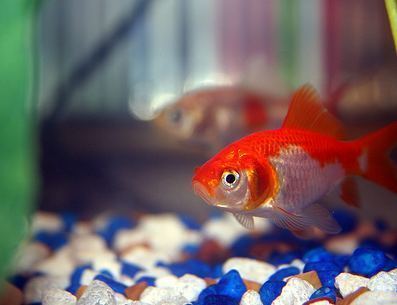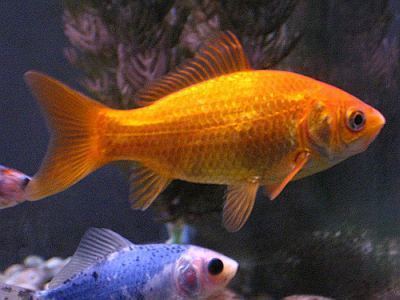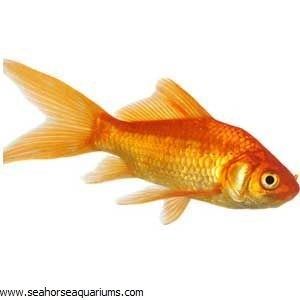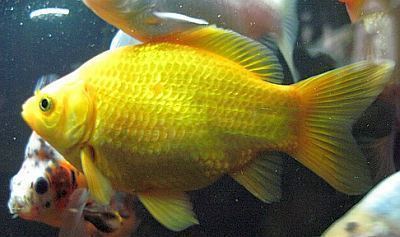Scientific name Carassius auratus Rank Breed | Higher classification Goldfish | |
 | ||
Similar Comet, Ryukin, Shubunkin, Telescope, Ranchu | ||
The common goldfish, also known as feeder fish, is a type of goldfish with no other differences from their ancestors other than their color. Goldfish are a form of domesticated wild carp and are a close relative of koi. Most varieties of fancy goldfish were derived from this simple breed. Common goldfish come in a variety of colors including red, orange, yellow, white, black, and calico goldfish.
Contents

Common goldfish
Temperament

Common goldfish are social animals who prefer living in groups. They are able to interact with any fish belonging to the same species. With provision of adequate care and attention, common goldfish can become tame. Once familiar with the face of its owner, swimming towards the fish keeper during feeding time can be observed and hand-feeding becomes possible. Small goldfish will normally avoid any form of human contact. However, this fear ceases in a middle-sized and mature goldfish. A full-grown goldfish is more likely to eat directly from the hands of its owner without evident hesitation. While this behavior is welcomed by goldfish owners, it proved problematic in outdoor ponds where predators may eat such friendly prey. Mature goldfish will also explore their surroundings through nibbling or grazing behavior.

If transferred into a tank of other goldfish, a common goldfish would normally try to communicate and familiarize itself with its new tank mates by rubbing up against the body of other fish. The most common introductory gesture would be by swimming side by side with another goldfish with its head facing forward, or by swimming side by side with another goldfish with its head facing the opposite direction, or even by swimming above another goldfish in a perpendicular fashion. Schooling is a common behavior when there is a new fish in the tank. After some time, this schooling behavior eventually ceases, and soon every individual fish will again be swimming and exploring the aquarium on its own. Aggressive behavior is uncommon when a new specimen is introduced into a settled school of goldfish.

Hierarchy during feeding is commonly observed in which the larger goldfish receives most of the food. However, small goldfish may also become aggressive or competitive feeders despite the presence of larger fish which is, in general terms, considered a good sign, as a willingness to feed is indicative of a healthy goldfish.
Housing

It is a common practice to keep common goldfish in a small bowl but this allows waste in the water to build up to toxic levels and does not provide enough oxygen. For every small/young goldfish there should ideally be at least 10 to 20 US gallons (38 to 76 l; 8.3 to 16.7 imp gal) of water. A good filter, with no heater, is recommended because these fish can get larger than 12 inches (300 mm). Tank recommendations range up to 75 US gallons (280 l; 62 imp gal). It is possible to keep small goldfish in smaller tanks, but such an arrangement will be very difficult to maintain once the fish grows older. If there is concern about the fish not getting enough oxygen, particularly when it is warm, a water pump, such as a fountain pump, mini pond pump will pull the CO2 water from the bottom, expel it, and the surface action will oxygenate the tank or pond. Contrary to popular belief, air pumps and air stones do not oxygenate directly and rely on bubbles breaking the surface to transfer oxygen to the fish's environment. Ideally the water pump should push 10x the volume of the tank or pond plus an extra 100lph or gph. Goldfish will die without sufficient dissolved oxygen in the water. A filter that can do at least 10x filtration is best, which means that for every 10 gallons or litres of water, the filter should be able to cycle 100 gallons or litres per hour. If the oxygen in the water runs out then the fish may die or become unconscious. It is advised to move the fish to a basin of water full of fresh water.

Goldfish are curious fish that will quickly become bored without items or other fish to interact with. If placed in a bare aquarium, goldfish will settle to the bottom and only move when fed or frightened by sudden jolts. However, if put in a tank with sufficient gravel, aquarium accessories or plants (real or fake) they will make themselves at home.
Goldfish are not very territorial. However, if your aquarium is already too small for one goldfish, it will certainly be too small for two or more. Stress is not healthy for any goldfish. In a worst-case scenario, one or two fish will bully the rest to starvation. Cannibalism is usually rare (occurring maybe when a fish is dying or dead) but in cramped, stressful situations, goldfish may behave unpredictably. Disease is possible any time fish are stuck in small homes.
When adding goldfish to a new tank it is important to place no more than two at a time. This allows helpful bacteria (which turns ammonia to nitrite and finally to nitrate) to grow. If introduced in too great a number before these bacteria grow, the goldfish will die from breathing in too much of their own untreated excrement. Even after the development of the biological filter, it is necessary to change about 20% of the water at least one time a week, or as necessary to prevent a build-up of harmful nitrate. The addition of live aquatic plants may reduce the number of times per month one will have to perform water changes, but only if the plants are growing (they will uptake nitrate as a source of nitrogen). But it is also recommended if the needs are required, To never remove all of the water out of an established tank. Never do a water change over 90%, the remaining 10% of water will help maintain the waters cycle and the remaining good bacteria will soon reestablish in the tank. A good tip is when doing a water changes is not to clean the filters at the same time(filters also hold a good amount of the good stuff as well) wait 2 days after a water change to clean your filters out to keep a healthy constant balance.
Common goldfish can be kept in water gardens or outdoor ponds throughout the year. Outdoor ponds have similar care requirement as indoor tanks with some notable exceptions such as amount of sunlight, natural and artificial environment pollution (i.e. dead leaves, debris, runoff), algae, selection of pond mates (i.e. algae eaters, frogs, etc.). Outdoor ponds tend to become miniature aquatic ecosystems, attracting various animals and plants (see water gardens for more information). In hot climates, it is important that pond temperatures do not rise to dangerously high levels which will kill the fish. In the winter, fish may become sluggish and stop feeding. This does not mean they are sick, but rather that their metabolism has slowed. The pond must not freeze solid and there should be an open spot in the surface ice to allow oxygenation of water. The ice should also not be struck, as this sends shock waves of sound pressure through the water scaring the fish.
Breeding
Breeding common goldfish is relatively easy. In breeding condition the male will develop small white spots on his gill covers and the female will become plump. The male will chase the female until she releases her eggs, then the male will release milt and they will become fertilized. The eggs will then stick to any available surface. It is then best to remove the eggs to a separate aquarium as the adults are likely to eat them. When the eggs hatch into fry, they will need to be fed very small food such as hatched brine shrimp or a ready made fry food. As they grow bigger, they can eat finely crumbled fishfood. Eventually the pieces of fishfood can get bigger.
Diseases
Common goldfish are usually hardy but can also contract diseases. These can be caused by poor water quality, overfeeding and overstocking. Goldfish are notoriously dirty, producing much waste, and continually stir up the substrate in their infinite search for food. In small aquariums, illnesses in common goldfish can quickly become fatal requiring quick and prompt treatment. Several symptoms can indicate sick fish such as cuts on any of the fins, a change in scale or eye coloration, excretions from the nostrils, scales falling off or the fish frequently rising towards the water surface. Many specialty treatments are available in the market to manage specific diseases.
Some of the main diseases frequently picked up by common goldfish are:
Fin rot is the rotting of the fins. Medication can be found in pet/fish stores. It is not fatal.
White spot disease is very fatal and very easy to treat. Medication can be found in pet/fish stores.
Ammonia poisoning is caused by a high level of ammonia in the tank. Add ammonia reduction chemicals to the tank, or for an emergency release of ammonia, change the water 25 percent daily for one week until the symptoms die down. Ammonia reduction chemicals must not be added as soon as the ammonia levels drop (as ammonia removers can starve the biological filter and cause the cycling process to start over)
Fish lice is a parasite. Fish lice move on the body of fish. They are the only visible parasites. They look like white see-through splodges. These lice can have nasty health side effects to your fish. Try to avoid removing the lice manually; use anti-parasite medicine.
Bacterial diseases can be deadly; they must treated immediately. An effective and safe treatment is Myxazin by Waterlife. A 50% water change is recommended before commencing treatment. Be sure to complete the prescribed course.
Lifespan
Goldfish can live for long periods of time if they are fed a varied diet and housed in proper water conditions. The longest lived goldfish on record lived to age 43. Improper care or life in a bowl greatly reduces the typical lifespan of a goldfish.
Goldfish as feeder fish
Common goldfish are often used as live prey for freshwater turtles, notably red-ear sliders and other carnivorous fish, such as the oscar. When fed exclusively, feeder goldish are not a good source of nutrients.
